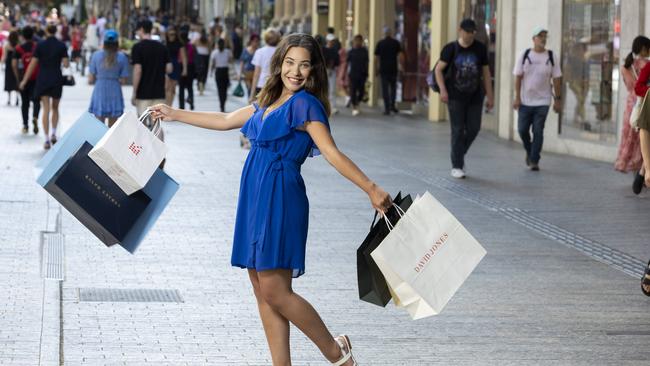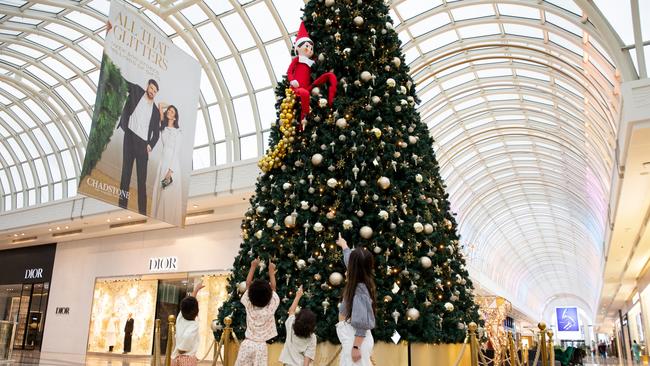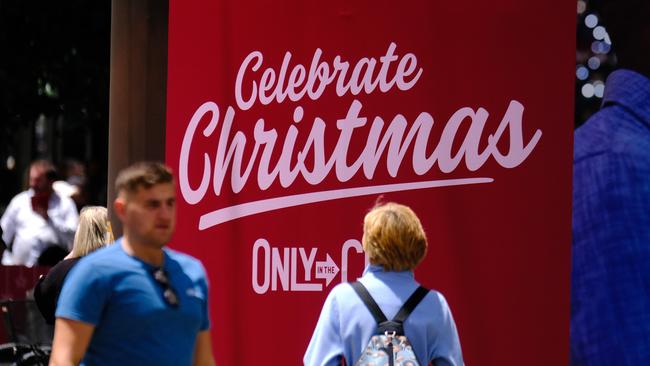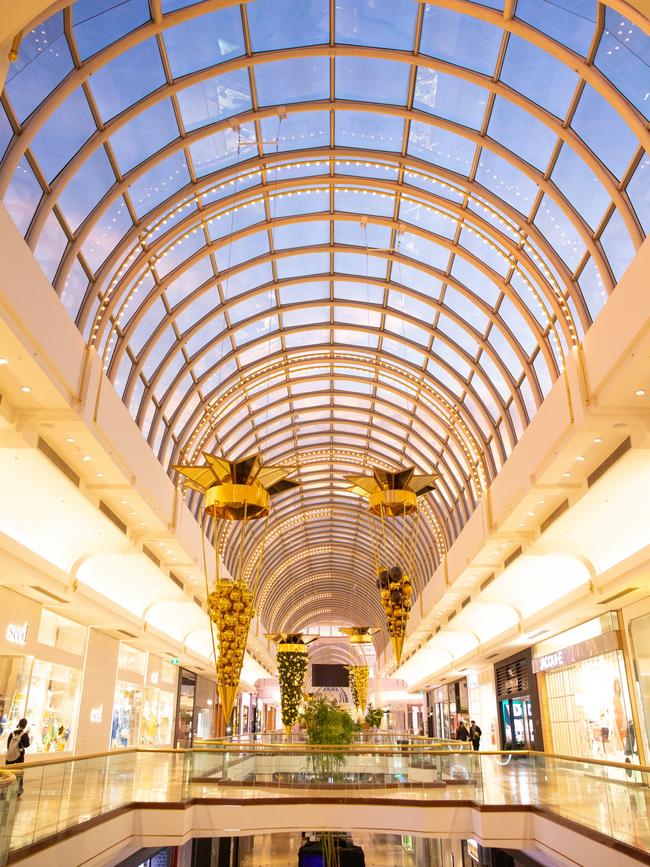Retailers pin their financial hopes on the bright lights of Christmas
Visiting Melbourne’s Chadstone shopping centre decked out for the festive season, it’s easy to forget bills piling up at home – and retailers nationally hope that’s a broad trend.

When you walk into Melbourne’s Chadstone shopping centre, the behemoth mall, owned by Vicinity Centres and the largest shopping centre in the southern hemisphere, it’s easy to get carried away with the Christmas spirit and forget those pesky bills piling up at home.
That’s the power of Christmas, and the dazzling lights and displays that come along with it. As an estimated 4.5 million people walk through Chadstone’s doors this festive season, they will be greeted by more than 1 million twinkling lights and 100km of fairy lights that will illuminate the centre, while an army of handpainted nutcrackers and soldiers stand guard. And if that’s not enough, a luxury Christmas tree near the Tiffany & Co store will show off about 22,500 tree branch tips displaying 2700 large baubles.
The bills can always wait until next year – that’s the hope of retailers and shopping centre owners anyway – because cost-of-living pressures are likely to play a key role in Christmas spending this year, more than in the last decade.
The Australian Retailers Association is tipping pre-Christmas sales to hit $67.4bn, up 1 per cent, for the November-December 24 trading period, with about $9bn of that to be splurged in the final week to Christmas Day. Over the pre-Christmas period, food spending is forecast to encompass the lion’s share of spending, making up $27bn of the overall spend, up 3.2 per cent from 2022, but many retail categories will be flat or down for the year.
And even with a rise of 3.2 per cent for food spending and 1 per cent for overall Christmas spend, that greatly lags inflation running at more than 5 per cent to underline the fact that people will be spending less in real terms.

Many retailers believe that too much of the shopping has been dragged forward into November due to the deep discounts and promotions on offer for the Black Friday and Cyber Monday weekend, with that trading event eclipsing Boxing Day sales.
Sure there is some fuel left in the tank for late December and, with Christmas Day falling on a Monday, there is the rare opportunity of a full weekend of shopping before the big day. But all indicators point to consumers reining in their spending this year as bills such as higher mortgage repayments, rents and utilities follow them in from the car park to the store.
Apart from Santa Claus, Chadstone centre manager Daniel Boyle just might be the busiest man in Australia right now as he oversees the centre’s final trading days before Christmas Day, when he and his staff can rest for one day and then quickly reopen for the Boxing Day sales.
“There is a really positive vibe throughout the (shopping centre) and people are taking advantage of extended shopping hours, and it has been a really terrific, smooth period so far and no doubt we will get busier over the next couple of days,” Mr Boyle told The Weekend Australian.

“At the moment we see people being a little bit more careful around where they will spend, so the shift often moves to discount department stores, and ‘everyday’ specialty retail, so people are still spending, sales are still strong.
“We are still seeing very high customer traffic so we are not seeing any unusual or substantial changes in the number of people that are coming through the centre … but overall performance has remained very strong.”
People have taken to the streets and shopping centres to look, and buy when the right deal pops up, with the traditional Myer Christmas windows in Melbourne’s Bourke St Mall attracting record attendances of more than 1.8 million visitors, against Myer’s forecast of 1.2 million.
Apart from the Myer windows, which this year have been inspired by children’s cartoon Bluey, shoppers are also out in force hunting for bargains as retailers and economists argue that with household budgets under pressure, stretching that disposable income as far as possible has become a key influence on shopping behaviour.
CBA chief economist Stephen Halmarick is seeing growing evidence of the sales in November with their steep discounting dragging forward spending, to leave less in the kitty for the final weeks before Christmas.
“The increase we’ve seen in spending at discount and variety stores in November is partly explained by Christmas and holiday shopping with discretionary spend up 1.9 per cent,” Mr Halmarick said. “However, people are also using the sales to stock up on essentials – with essential spending edging up 0.3 per cent.

“Essential spending usually falls after the ‘gift giving’ period. However, given consumers are clearly seeking sales bargains for both essential and discretionary items, Boxing Day sales could also see a similar trend, with a larger share of essential spending.”
Some retail experts believe the Black Friday sales are now bigger than Boxing Day and pull in sales that are about three times the value of a typical trading week during the year.
Chadstone’s Mr Boyle said: “If you looked at our total foot traffic between November and December before Black Friday became very popular in around 2019, there is a propensity to spend more in November and prepare to take advantage of those sales. It doesn’t put a dent in traffic as much as it changes the shift in spend.”
Chadstone is expected to attract a total of 170,000 people across this weekend and then more again on Boxing Day when the centre reopens.
E&P Capital retail analyst Phillip Kimber said the feedback from discretionary retailers was that they enjoyed a strong Black Friday-Cyber Monday period, helped by aggressive discounts that stimulated demand, particularly in the electronics and department store category.
“While the Black Friday period is very important – as it’s now the largest sales period – the unknown was whether sales were either delayed (in the month leading in) or pulled forward (from the month after) to take advantage of the aggressive discounts,” Mr Kimber said.
Recent credit card data from ANZ highlighted this pull forward of sales, noting that year-on-year sales momentum for several key discretionary spending categories was weak outside of the Black Friday-Cyber Monday period.
ANZ data revealed sales for the 10-week period to December 9 for the electrical category fell 2 per cent, while for the almost three weeks to December 17, year-on-year sales momentum deteriorated for all key categories (except outdoor) compared to the 10 weeks to December 17.

Consumer electronics spend was down 8 per cent, against down just 2 per cent for the 10 weeks to December 17, and furniture sales were down 13 per cent, versus down 9 per cent for the 10 weeks to December 17.
“The remaining weeks of calendar 2023 including the Boxing Day sales period are still a very important trading period. However, if the trend of deteriorating sales momentum outside of key events remains weak, we expect to see a pullback in some of the share prices,” Mr Kimber added.
Some of those cracks have already started to appear, with KMD Brands, owner of outdoor adventure wear retailer Kathmandu and surf brand Rip Curl, warning this week of a significant slowdown in sales heading into Christmas (a trend that had worsened since August), which sent its share price diving.
Consumers and retailers will soon turn their attention to what 2024 brings, with ANZ economists predicting the starting point for the household sector to be one of weakness in household disposable income, reflecting the combined impact of a string of interest rate rises by the RBA and a surge in tax paid by the household sector fuelled by bracket creep and the removal of the low and middle income tax offset.




To join the conversation, please log in. Don't have an account? Register
Join the conversation, you are commenting as Logout